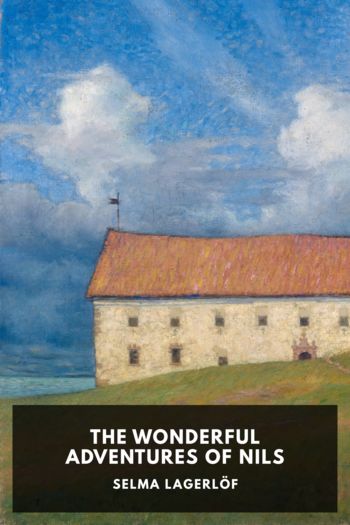The Wonderful Adventures of Nils, Selma Lagerlöf [best sales books of all time .txt] 📗

- Author: Selma Lagerlöf
Book online «The Wonderful Adventures of Nils, Selma Lagerlöf [best sales books of all time .txt] 📗». Author Selma Lagerlöf
When the boy, who lay under the thistle-leaf, saw this, he sprang up as if he wanted to take the goosey-gander away from them; then he must have remembered how little and powerless he was, for he threw himself on the knoll and beat upon the ground with his clenched fists.
The goosey-gander cried with all his might for help: “Thumbietot, come and help me! Oh, Thumbietot, come and help me!”
The boy began to laugh in the midst of his distress. “Oh, yes! I’m just the right one to help anybody, I am!” said he.
Anyway he got up and followed the goosey-gander. “I can’t help him,” said he, “but I shall at least find out where they are taking him.”
The children had a good start; but the boy had no difficulty in keeping them within sight until they came to a hollow where a brook gushed forth. But here he was obliged to run alongside of it for some little time, before he could find a place narrow enough for him to jump over.
When he came up from the hollow the children had disappeared. He could see their footprints on a narrow path which led to the woods, and these he continued to follow.
Soon he came to a crossroad. Here the children must have separated, for there were footprints in two directions. The boy looked now as if all hope had fled. Then he saw a little white down on a heather-knoll, and he understood that the goosey-gander had dropped this by the wayside to let him know in which direction he had been carried; and therefore he continued his search. He followed the children through the entire wood. The goosey-gander he did not see; but wherever he was likely to miss his way, lay a little white down to put him right.
The boy continued faithfully to follow the bits of down. They led him out of the wood, across a couple of meadows, up on a road, and finally through the entrance of a broad allée. At the end of the allée there were gables and towers of red tiling, decorated with bright borders and other ornamentations that glittered and shone. When the boy saw that this was some great manor, he thought he knew what had become of the goosey-gander. “No doubt the children have carried the goosey-gander to the manor and sold him there. By this time he’s probably butchered,” he said to himself. But he did not seem to be satisfied with anything less than proof positive, and with renewed courage he ran forward. He met no one in the allée—and that was well, for such as he are generally afraid of being seen by human beings.
The mansion which he came to was a splendid, old-time structure with four great wings which enclosed a courtyard. On the east wing, there was a high arch leading into the courtyard. This far the boy ran without hesitation, but when he got there he stopped. He dared not venture farther, but stood still and pondered what he should do now.
There he stood, with his finger on his nose, thinking, when he heard footsteps behind him; and as he turned around he saw a whole company march up the allée. In haste he stole behind a water-barrel which stood near the arch, and hid himself.
Those who came up were some twenty young men from a folk-high-school, out on a walking tour. They were accompanied by one of the instructors. When they were come as far as the arch, the teacher requested them to wait there a moment, while he went in and asked if they might see the old castle of Vittskövle.
The newcomers were warm and tired; as if they had been on a long tramp. One of them was so thirsty that he went over to the water-barrel and stooped down to drink. He had a tin box such as botanists use hanging about his neck. He evidently thought that this was in his way, for he threw it down on the ground. With this, the lid flew open, and one could see that there were a few spring flowers in it.
The botanist’s box dropped just in front of the boy; and he must have thought that here was his opportunity to get into the castle and find out what had become of the goosey-gander. He smuggled himself quickly into the box and concealed himself as well as he could under the anemones and colt’s-foot.
He was hardly hidden before the young man picked the box up, hung it around his neck, and slammed down the cover.
Then the teacher came back, and said that they had been given permission to enter the castle. At first he conducted them no farther than the courtyard. There he stopped and began to talk to them about this ancient structure.
He called their attention to the first human beings who had inhabited this country, and who had been obliged to live in mountain-grottoes and earth-caves; in the dens of wild beasts, and in the brushwood; and that a very long period had elapsed before they learned to build themselves huts from the trunks of trees. And afterward how long had they not been forced to labour and struggle, before they had advanced from the log cabin, with its single room, to the building of a castle with a hundred rooms—like Vittskövle!
It was about three hundred and fifty years ago that the rich and powerful built such castles for themselves, he said. It was very evident that Vittskövle had been





Comments (0)